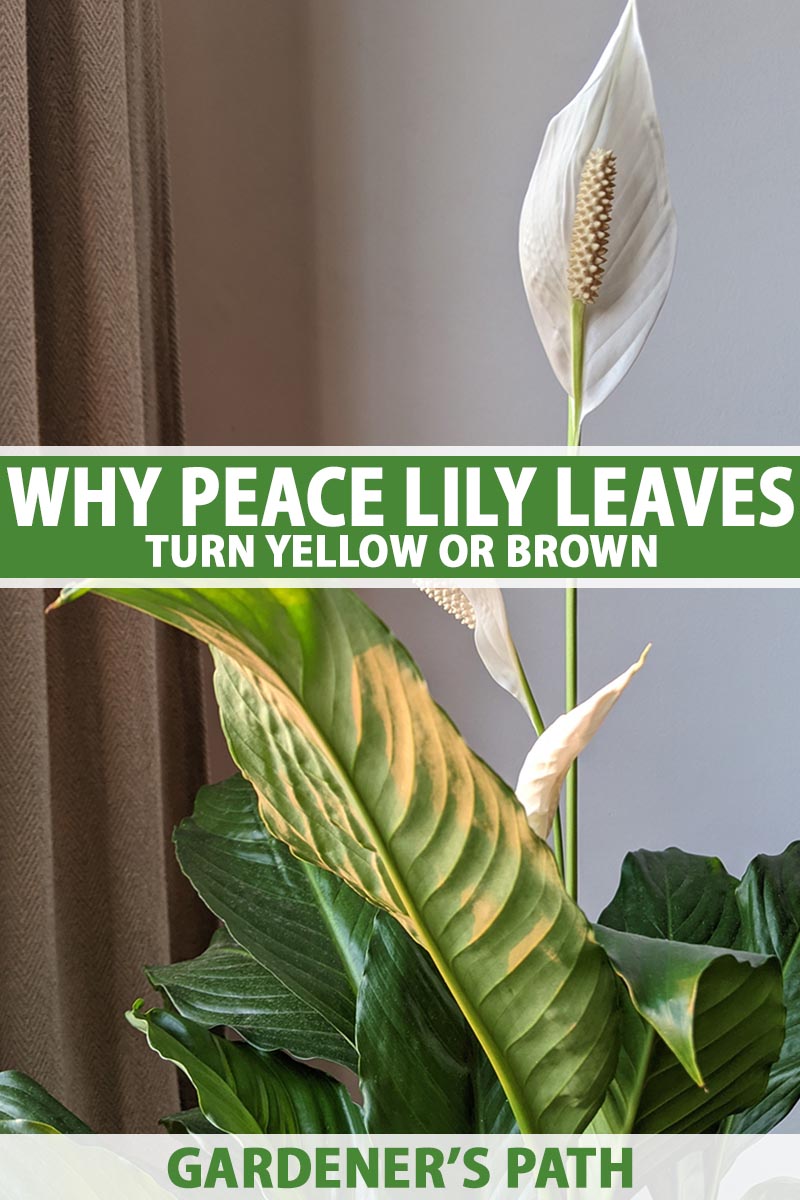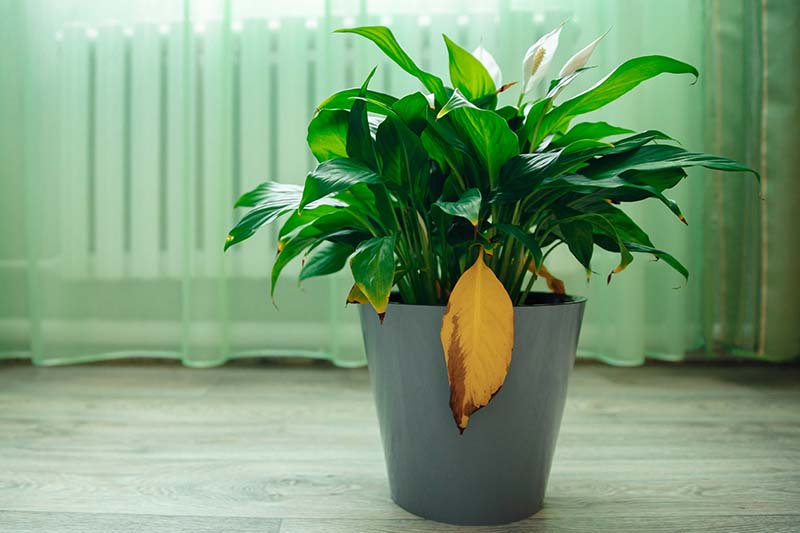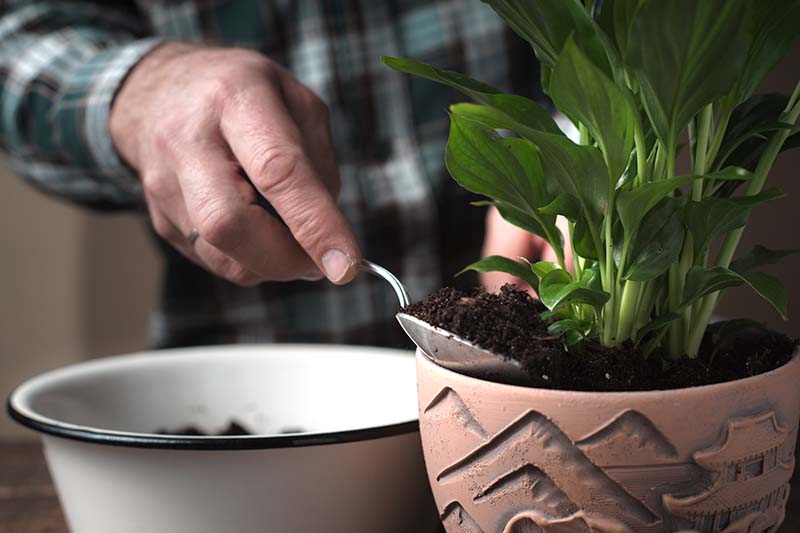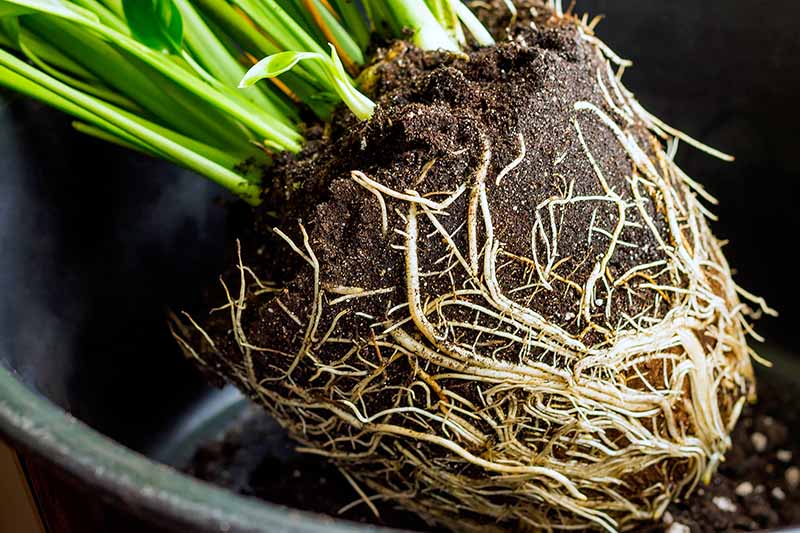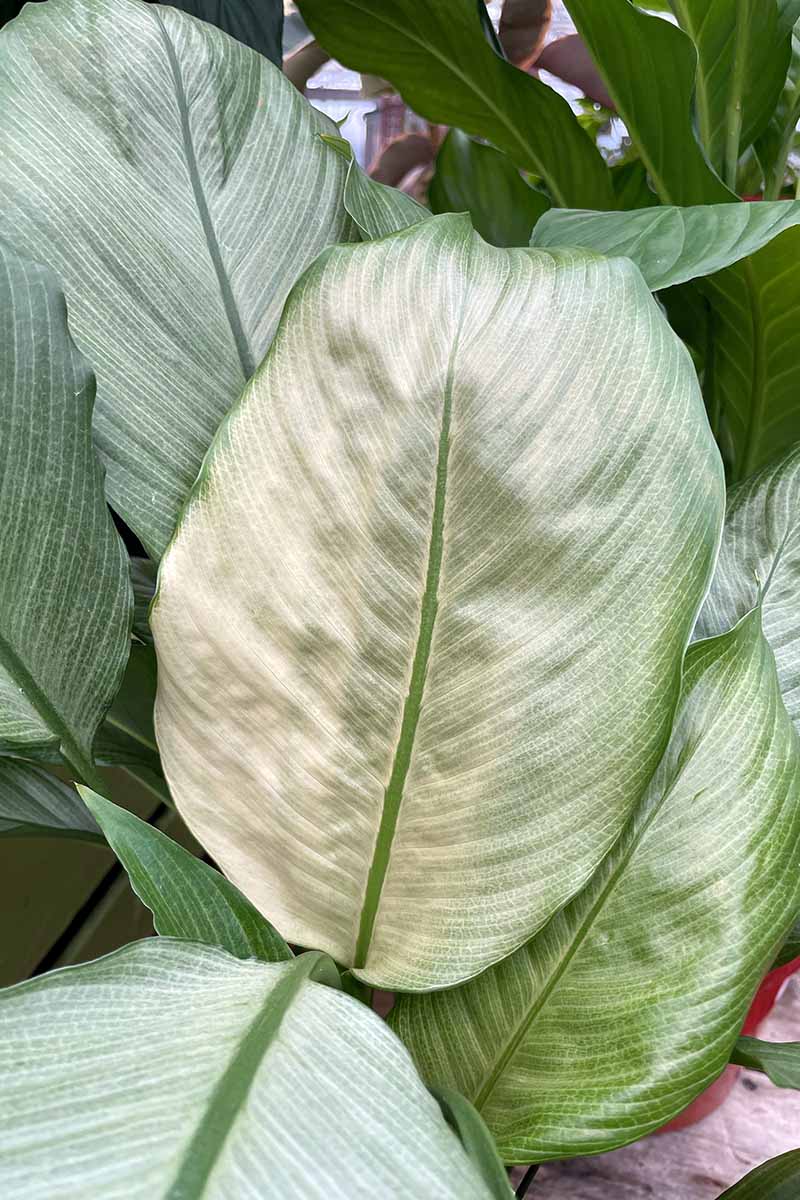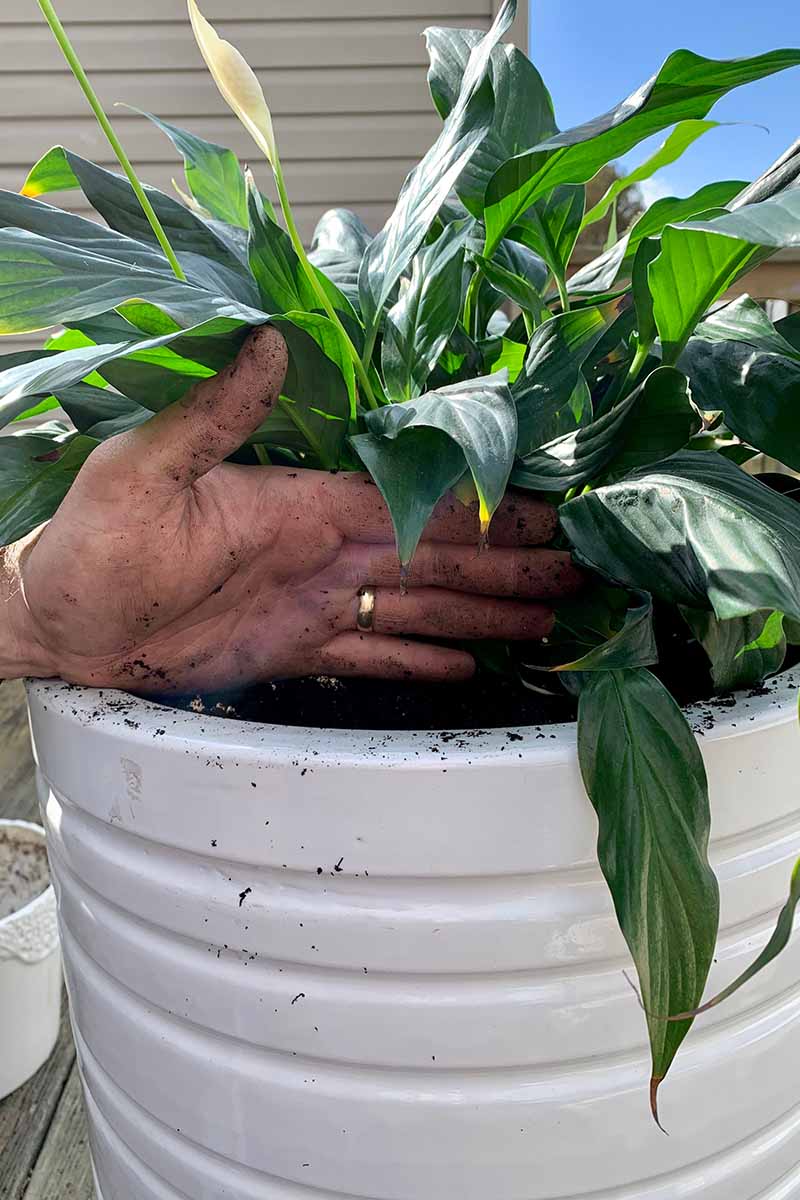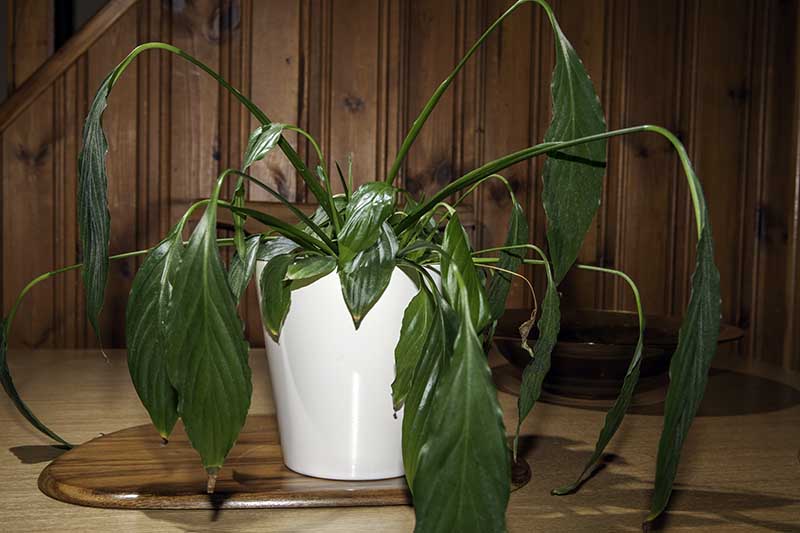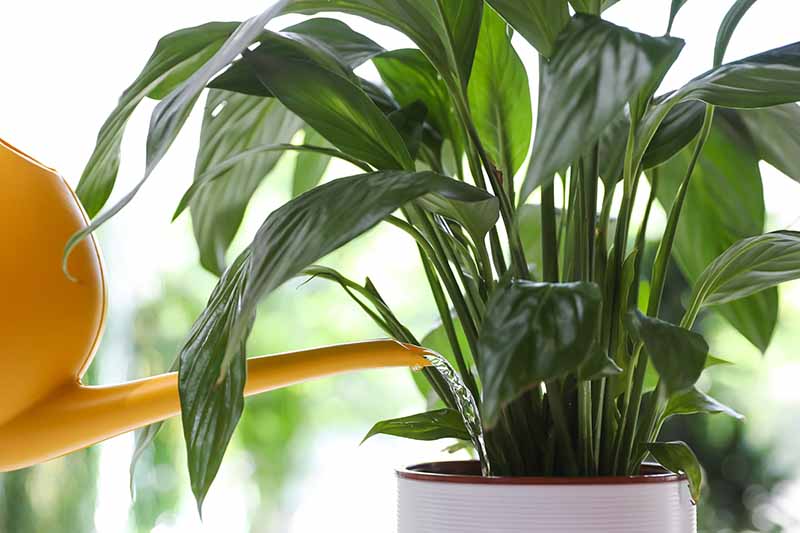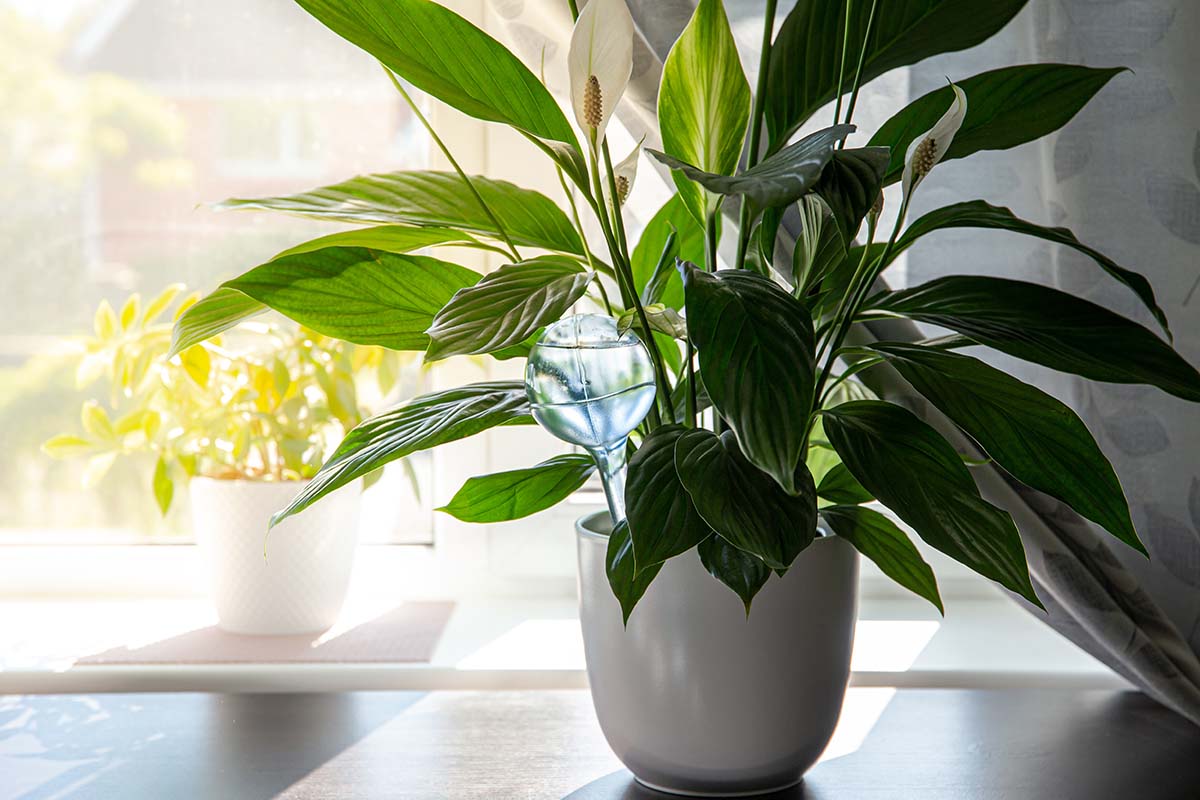Plants in the Spathiphyllum genus that grow wild in tropical parts of Mexico, Central America, South America, and Southeast Asia, can be cultivated outdoors in the US in Puerto Rico, southern Florida, and Hawaii. Those pretty white “flowers” that you’re probably familiar with are in fact modified leaves called spathes, and that spiky post in the middle is called a spadix. Together, they’ve evolved to form an appealing attraction to encourage pollinators to come and visit the tiny flowers covering the spadices when they’re in bloom. We link to vendors to help you find relevant products. If you buy from one of our links, we may earn a commission. If you’d like to learn more about growing peace lilies, our guide has lots of useful information to help you get started. Yellow or brown foliage is an indication that your plant isn’t happy, and there are quite a few things that can cause leaf discoloration. It’s your plant’s way of showing that things aren’t all well. Unfortunately, since we don’t speak fluent Plant, it’s up to us as gardeners to try to determine exactly what the problem is in other ways. In addition to pruning, it’s important to do your best to determine the root cause, so you can keep your plant healthy and prevent it from happening again. Let’s take a look at the top culprits. In this guide, we’ll cover 9 of the top reasons for leaf discoloration in peace lilies, and what you can do to remedy or alleviate the issue that’s causing it. Here’s what we’ll go over up ahead: Ready to return those peace lilies to their former glory? Here we go!
1. Aging
Plant leaves don’t last forever. We tend not to notice foliage yellowing and dropping as it ages on plants with lots of small leaves, like weeping figs, but aging leaves are a lot more obvious on plants with larger leaves like peace lilies. That can make growers panic, but don’t stress out just yet. As the leaves age, they will eventually turn yellow and die off. Young, new leaves are constantly forming and replacing older foliage in healthy plants, so it’s nothing to worry about. If the yellow leaves are all on the outside and only a few are forming at a time here and there, you can be fairly confident they’re just aging. This is doubly true if the rest of the plant appears to be perfectly happy, and fresh, young leaves are forming as well. Trim the yellow leaves off and let the cycle of life continue.
2. Fertilizer Issues
Testing garden soil is a common outdoor chore, but few people think to test their potting soil. If your plants have discolored leaves, it’s worth doing. A lack of nitrogen can result in pale yellow foliage. But you don’t want to go tossing in lots of fertilizer if your Spathiphyllum doesn’t need it. That can cause all kinds of issues too – including yellowing and brown leaves. In the future, watering thoroughly and deeply can help to flush excess fertilizer out of the soil rather than adding water more lightly and frequently. Bat guano is an excellent option to increase nitrogen without adding potassium or phosphorus if your soil isn’t deficient in those as well. Down to Earth supplies bat guano fertilizer in compostable boxes. Down to Earth Bat Guano You can purchase it in quarter-pound, two-pound, and ten-pound boxes at Arbico Organics. Fertilizer builds up pretty rapidly in the soil. If too much builds up in your peace lily’s container, the leaves will turn yellow and brown, starting with browning at the edges of the leaves. If this is the problem, you will need to remove the existing soil and replace it with new potting soil. It’s not a bad idea to do this every few years, anyway. If you aren’t sure if this is the problem at hand, but it has been a while since your plant was repotted last, go ahead and refresh the soil just to be safe. Don’t use the technique of bottom watering if you’re having trouble with fertilizer building up – water at the soil line from above instead and let the excess drain well in the sink or tub, or be sure to dump out the saucer or cachepot beneath the container. Learn more about fertilizing peace lilies here.
3. Light Exposure
Spathiphyllum plants don’t like direct sunlight. They grow in the wild in the understory of rainforests, which means they rarely see direct sun. If your peace lily has too much sun hitting it, the leaves will turn brown at the edges, or become yellow overall with green veins.
4. Low Humidity
Low humidity may also cause the tips of the leaves to turn brown. This is more common during the winter when forced-air heating dries your home’s interior out. Unlike when they receive too much light, you won’t see browning edges and tips. Plants that receive too little light might also fail to produce spathes and flower. Too little light is usually less of a problem than too much, in terms of overall plant health. In either case, move the plant to an area with the appropriate amount of light. Six to eight hours a day of bright, indirect, or filtered light is ideal. 5-in1 Soil Moisture Meter Alternatively, a dedicated light meter can take the guesswork out of resolving the situation. A plant sitting near a draft, in direct sun, or in a warm area can also lose moisture quickly. Peace lilies come from tropical regions with high humidity, so try to provide them with 50 percent or higher humidity if this level doesn’t occur naturally. There are a few ways to increase humidity. One of the easiest methods is to simply place plants together in a group. They’ll collectively raise the humidity in the immediate area. You can also place your Spathiphyllum on a tray filled with pebbles and water, use a room humidifier, or mist the foliage once or twice a day. You might only need to increase humidity during part of the year. You don’t want to add too much moisture, which can encourage disease, so keep an eye on the changing humidity levels. A multipurpose soil moisture meter, like the one mentioned above, will give you humidity readings as well.
5. Pests and Disease
There are two types of pests to watch out for with peace lilies grown as houseplants, and both can cause leaf discoloration. Mealybugs (family Pseudococcidae) suck the sap out plants, which results in overall weakness and stunted growth. In large enough numbers, these insects can cause wilted, yellowing leaves or brown tips, spots, and edges. Our guide to controlling mealybugs provides more information for dealing with these common pests. Brown scale (Coccus hesperidum) is the other most common type of insect to keep an eye out for. These also suck the sap out of plants and cause similar symptoms to a mealybug infestation. The easiest way to tell the difference is by identifying the bugs, and then tailoring your line of attack accordingly. Our guide can help you to control a brown scale situation. There are a few diseases that can cause Spathiphyllum leaves to turn yellow or brown. These include cylindrocladium root rot, dasheen mosaic virus, leaf blight, and pythium root rot. Here are a few tips to help you tell the difference between these so you know how to tackle them: Cylindrocladium root rot causes only the lower leaves to turn yellow. You may also see wilting leaves on the entire plant. Dasheen mosaic virus, on the other hand, causes yellow mottling on the foliage and impacts new and old leaves alike. Leaf blight usually causes leaves to turn brown. The brown spots might be mushy and wet, or they could be dry and crisp. Pythium root rot results in wilted, pale yellow foliage on part or all of the plant. For more information on identifying and eliminating these diseases, check out our comprehensive guide to peace lily diseases.
6. Transplant Shock
If yellowing happens shortly after transplanting and you don’t see browning tips, the plant has likely gone into shock. Peace lilies are pretty hardy, and transplant shock isn’t extremely common, but that doesn’t mean it never happens. The first sign is usually wilting, followed by yellowing if the plant doesn’t quickly recover. Keep watering as you normally would, and don’t expose the plant to too much light, and it should recover in time. Don’t fertilize, and trim off any dead leaves. It’s fine to allow wilted ones to stay in place until the plant recovers, to avoid causing further stress.
7. Watering Issues
First of all, you shouldn’t even try to grow a peace lily in a container without drainage holes. You will have an extremely difficult time keeping the plant as moist as it prefers to be without inadvertently overwatering and leaving the roots in sitting water, and oversaturated soil will quickly kill your plant. If this is the cause of foliage discoloration, you’ll see wilted yellow leaves. You should water any time the top inch of soil dries out. Remember to always dump out the catchment saucer about half an hour after watering. Underwatering and overwatering can look very similar, and both can cause yellowing leaves. But underwatering can also cause dry, brown edges and tips. It’s also usually accompanied by wilting and drooping. Peace lilies won’t usually turn yellow just because you miss a watering session now and then. This is more of a problem if you are chronically underwatering. Don’t let more than the top inch of soil dry out, and consider investing in a moisture meter to keep on top of the situation. A soil moisture meter can be a huge help if you’re having trouble gauging the correct moisture level in your containers. You can learn more about how to water peace lilies in our guide.
8. Water Quality
Most of the time, we just run to the sink and fill up our watering cans without thinking twice. But Spathiphyllum species may require a little extra consideration for optimum health. Many municipal water systems are chlorinated, and the water in homes with softening systems contains high levels of sodium. Over time, this sodium builds up and negatively impacts the health of your plant. Peace lilies are known to be particularly sensitive to an overabundance of salt or chlorine, which can build up in the soil. Check to see if your city adds chlorine to the water. If it does, you can avoid upsetting your peace lily by using a letting your water sit overnight so the gas can evaporate. You can also use a water filter, reverse osmosis, or buy filtered water if you choose. If you have a water softener, use water from an outlet that doesn’t pass through your softener, like an exterior tap or perhaps your kitchen tap. You can also buy filtered water or use reverse osmosis to remove salt.
9. Temperature Issues
Most people keep their houseplants in the same areas of the home where they live, which means the temperatures stay pretty consistent. But if you happen to have yours in a basement, vestibule, or unheated room during the winter, low temperatures can cause the foliage to turn yellow or brown. I once worked in an office that was filled with peace lilies, but they all started to look a bit sad one year. We realized that in our efforts to save energy by turning the thermostat down to 50 when we were out of the building, we were hurting our green friends. If the temperature consistently hovers in the low 40s to high 50s, the leaves reveal their stress by becoming discolored. The solution, of course, is to move them to a warmer place or turn up the thermostat. When it’s too hot for your peace lily, the leaves will tell you by turning yellow or brown. The brown portions will be dry and are usually found only on the edges and tips of the leaves, and any yellow areas will be bright in color rather than pale. When the temperature regularly climbs above 85°F degrees, you’ll likely start to see discoloration. Give your plant more shade, or move it to a cooler spot. With this guide, you should be on the right track to determine what went wrong, and how to solve the issue or prevent it from happening again. What was the cause of leaf discoloration in your plant? How did you fix it? Let us know in the comments below so we can help other readers who may be struggling with the same situation. If this guide helped you to bring the green back to your peace lily, you might want to expand your knowledge by reading one of our other articles on this beautiful bloomer, starting with these:
5 Reasons Why Peace Lilies May Not Bloom5 Common Reasons Why Peace Lily Leaf Tips Turn BrownAre Peace Lilies Toxic to Cats?
